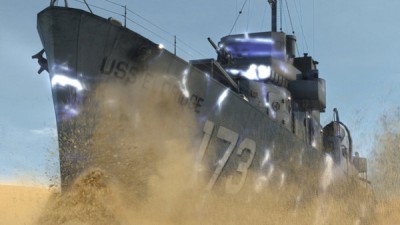| Reviews & Columns |
|
Reviews DVD TV on DVD Blu-ray 4K UHD International DVDs In Theaters Reviews by Studio Video Games Features Collector Series DVDs Easter Egg Database Interviews DVD Talk Radio Feature Articles Columns Anime Talk DVD Savant Horror DVDs The M.O.D. Squad Art House HD Talk Silent DVD
|
DVD Talk Forum |
|
|
| Resources |
|
DVD Price Search Customer Service #'s RCE Info Links |
|
Columns
|
|
|
Philadelphia Experiment (2012), The
Eyeing it in our screener pile, I snapped up The Philadelphia Experiment mistakenly thinking it to be the 1984 science fantasy film I'd always been curious about but had never seen. Instead, it turned out to be a made-for-television semi-remake that aired on the awkwardly named Syfy (formerly Sci-Fi) Channel in 2012. Not having seen the original, I'm not in a position to make comparisons, but on its own merits this Philadelphia Experiment is quite awful, rife as it is with genre clichés, mostly unappealing and sketchily-defined characters, mediocre CGI effects, and several ginormous plot holes.
An Anchor Bay release, The Philadelphia Experiment* looks and sounds okay in 1080p high-def and 5.1 Dolby TrueHD audio, up to contemporary television standards. No extras.
Bitchy femme fatale Kathryn Moore (Gina Holden), representing the interests of a ruthless, Halliburton-type conglomerate, is only mildly impressed when smug, cocky scientist ("I'm terribly clever") Dr. Richard Faulkner (Ryan Robbins) and his team appear to have succeeded in developing cloaking technology, and in a demonstration render Moore's car invisible. However, their actions also cause a time-space rip that literally pulls the USS Eldridge, a destroyer escort that had been working on similar invisibility experiments in 1943, forward through time and space and into the present. With great overuse of electro-plasma CGI effects, the destroyer appears suddenly on the runway of a rural Pennsylvania airport.
The crew is dead save for Capt. Bill Gardner (Nicholas Lea). In the first of several outrageous contrivances, the ship just so happens to come to rest a stone's throw from Gardner's hometown, which in 2012 he finds almost unrecognizable. (These scenes are badly overdone, with practically every background extra over-emphatically yacking on a cellphone, while hip-hop music blasts from passing cars and an extravagantly tattooed punk girl glowers at the nonplussed sailor.)
He makes his way to the house he bought 70 years ago, there finding his adult granddaughter Molly (Emilie Ullerup), a waitress at the local coffee shop who also happens to be an expert computer hacker, a skill that comes in handy later in the story. Moore, learning of Gardner's existence, dispatches hit man Hagen (Michael Paré, who played a different part in the 1984 film) to assassinate him. Gardner and Molly, dodging Hagen's bullets all the way, scramble to locate Morton Salinger (Malcolm McDowell), an "old friend" of Gardner's who was one of the leading scientists on the original Philadelphia Experiment back in '43.
Whoa-whoa-whoa. What's that you say? Apparently 2012 TV-movie writer Andy Briggs patterned McDowell's Salinger character after a similar character played by Eric Christmas in the 1984 movie but without considering the nearly 30 years that have since passed. Even if Salinger had been an unusually young scientist of, say, 25 back in 1943, he'd be 94 years old in 2012. And had McDowell worn old age make-up this might have been acceptable if straining credibility. But in The Philadelphia Experiment McDowell is just his ordinary, 68-year-old self. Granted, he's not the blond-haired youth of his Clockwork Orange and If… days, but still.
The movie is a textbook example of why sci-fi movies and TV films are so incredibly lousy these days. The movie plays like a very poor but greatly extended episode of Twilight Zone, relying heavily on time travel and dimensional-rip clichés, including a tiresome and utterly predictable "twist" ending. And I'm really, really weary of movies in which scientists and their corporate sponsors appear oh-so-blasé about the incredible, centuries-ahead-of-their-time technologies they've just created, and by the plebian counter-reaction to such things: to gape with stock-still awe at something amazing but dangerously close, when in real life everyone would be running like hell in the opposite direction.
The producers clearly want to have their cake and eat it, too. The Blu-ray packaging plainly identifies this as an "electrifying remake of the ‘80s hit" (well, there are all those electro plasma effects) but credits only Briggs. The 1984 film's writers, William Gray, Don Jakoby, and Michael Janover, from Wallace C. Bennett's story and the book by Charles Berlitz and William J. Moore, receive no story credit at all, though the assistant chef and creators of its electronic press kit do.
Beyond the clumsy writing, none of the characters is very interesting, with Moore and Faulkner coming off particularly tiresome. Gardner and Molly have more promise, but they've little do to other than flee the Terminator-like Hagen, appearing breathless and tense in almost every scene. McDowell, as the way-too-youthful nonagenarian, is onscreen for less than 10 of the film's 89 minutes.
Though not very logical, visually at least Briggs has one bright idea in having the USS Eldridge vanishing and reappearing in the most inconvenient of places. It first appears on that remote landing strip just as a small airplane is taking off, the craft crashing headlong into the destroyer. The ship later drops out of the sky above Chicago, landing atop a skyscraper there, then later still (and against unbelievable odds) rematerializes into two nuclear reactors in England, causing a massive nuclear explosion.
Unfortunately, the CGI effects are poorly done. In the movie, the USS Eldridge is the computer file equivalent of a bathtub toy. It looks unfinished and rather plastic. The unreality of the ship is further emphasized by the inauthentic interior sets, which look nothing at all like the real interior of a World War II-era vessel. Didn't the spfx or art departments bother to look at historical photographs or newsreels of the real Eldridge?
Video & Audio
Shot with Panavision equipment, The Philadelphia Experiment looks okay, considered its cheap, made-in-Canada TV movie origins. The 1.78:1 image is bright and clear, while the Dolby TrueHD 5.1 audio, English only with optional English and Spanish subtitle options, has rather overpowering bass that threatens to drown out the dialogue (not necessarily a bad thing), but isn't terrible. The disc, incidentally, is Region A encoded. No Extra Features.
Parting Thoughts
Good for a few incredulous laughs but little else, the made-for-TV, 2012 version of The Philadelphia Experiment is a bust. Skip It.
* Pennsylvania native Sergei Hasenecz notes, "A Philadelphia Experiment is any restaurant outside of eastern Pennsylvania claiming they make an 'authentic Philly cheese steak.'"
Stuart Galbraith IV is a Kyoto-based film historian whose work includes film history books, DVD and Blu-ray audio commentaries and special features. Visit Stuart's Cine Blogarama here.
|
| Popular Reviews |
| Sponsored Links |
|
|
| Sponsored Links |
|
|
| Release List | Reviews | Shop | Newsletter | Forum | DVD Giveaways | Blu-Ray | Advertise |
|
Copyright 2024 DVDTalk.com All Rights Reserved. Legal Info, Privacy Policy, Terms of Use,
Manage Preferences,
Your Privacy Choices | |||||||














